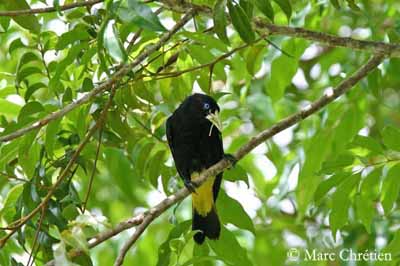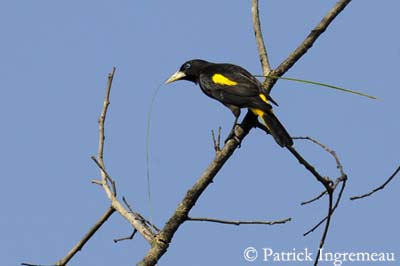
Yellow-rumped Cacique
Cacicus cela
Passeriforme Order – Ictéridae Family
BIOMETRICS:
Lenght: 24-28 cm
Weight: M : 100 g – F : 60 g
DESCRIPTION:
In Peru, Yellow-rumped Cacique appearance means “good news”!
DIET:
Yellow-rumped Cacique feeds mainly on fruits and insects such as beetles, caterpillars, crickets and it also catches spiders.
PROTECTION / THREATS / STATUS:
Yellow-rumped Caciques are common and widespread. It is the most common caciques’ species in Amazonia.
Fr: Cassique cul-jaune
All : Gelbbürzelkassike
Esp : Arrendajo Común
Ital : Cacico dal groppone giallo
Nd : Geelstuit-buidelspreeuw
Photographers :
Patrick Ingremeau
TAMANDUA
Steve Garvie
RAINBIRDER Photo galleries
Marc Chrétien
MURINUS
Text by Nicole Bouglouan
Sources :
NEW WORLD BLACKBIRDS – THE ICTERIDS by Alvaro Jaramillo and Peter Burke – Helm - ISBN: 0713643331
Arthur Grosset's Birds (Arthur Grosset)
Wikipedia (Wikipedia, The Free Encyclopedia)
SORA Searchable Ornithological Research Archive (Blair O. Wolf)

Adults have black and yellow plumage.
Upperparts are black, with yellow lower back and rump. Black upperwing shows a yellow patch on inner wing, very conspicuous in flight. Tail is black, with extended yellow base.
On the underparts, throat, breast and upper belly are black. Lower belly, vent and undertail coverts are yellow. Tail feathers are black. Underwing is black.
Head is black with a short black crest on the crown.
The long, sharp bill is whitish. Eyes are blue. Legs and feet are black.

Both sexes are similar in plumage, but female is smaller than male, and she lacks the short crest.
Immature resembles adult female with slightly duller plumage, mostly greyish or brownish. Eyes are brown. Base of the bill is brownish.
We can find three subspecies: Cacicus cela cela, Cacicus cela vitellinus and Cacicus flavicrissus. Morphology and voice are different according to each subspecies.
VOICE: SOUNDS BY XENO-CANTO
Yellow-rumped Cacique utters a loud “scheeooo” in flight. When foraging, it gives some “skeek”, or “weer” or “wrup”, and also harsh or melodious calls and whistles. Alarm call is a guttural “quack”, or a harsh “tchak” or “chaaak” loud and frequent.
Female utters a rough “rrrrrr” when aggressive.
The male’s song includes whistles, crackles, fluting notes and mimicries. While singing, the male bows, fluffs its rump and vibrates its wings.

HABITAT:
Yellow-rumped Cacique frequents open forests and edges, cultivated areas with trees and roadside clearings. It usually avoids dense forests, but it feeds in it. It is visible up to 900 metres of elevation.
RANGE:
Yellow-rumped Cacique is resident breeder in most parts of South America, from Panama and Trinidad, and southwards to Peru, Bolivia and Central Brazil.

BEHAVIOUR:
Yellow-rumped Cacique is a very gregarious bird. They nest in colonies and they roost in large noisy flocks. These flocks are conspicuous at dawn and dusk, during the flights between the roosts and the feeding areas. These birds forage in pairs or small groups usually including one male and several females.
Yellow-rumped Cacique often joins mixed flocks at fruit trees. Fruit is a great part of its diet. It also catches insects. They feed mainly in the canopy, but according to the period, they can forage in the understory or in mid or low level in canopy.

Yellow-rumped Cacique breeds in colonies. There is a hierarchy between males, with dominant and subordinates. Dominant males display and court receptive females while subordinate males act as sentinel, but they also wait for any opportunity to mate with unattended female.
Several males are present at colony at any time, but if hierarchy is followed, they tolerate each other.
Some fights occur when a subordinate tries to become dominant. Hierarchy depends on the weight of the males. The heaviest is dominant. But these dominant males have to stay at nest for guarding female, and little by little, they loose their weight and of course their status.
At night, only incubating females remain at the colony. All the other birds gather at communal roosts.
Females also have hierarchy, and oldest females are dominant. When younger females try to build their nests, the oldest steal the nest-materials and harass them. Very few young females complete their nests.

During courtship, the male performs displays. It is sat almost in horizontal posture with fluffed feathers, and particularly its rump feathers. Wings are fluttering and bill pointed downwards, while it bows forwards and utters harsh songs.
During these displays, the tail is raised and the yellow rump is displayed. Before copulation, the male solicits the female. It sleeks its plumage, but the yellow wing patches and undertail coverts are raised while it bows the head up and down. If female is receptive, she raises her tail and quivers her wings.
Then, male and female take off and perform chases, before to mate in the forest.
FLIGHT:
Yellow patches are very conspicuous in flight.
REPRODUCTION:
Breeding season varies, according to the range.
Yellow-rumped Cacique nests in colonies, but numbers of nests vary. Usually, in small colonies, the birds build their nest at the same time, whereas in larger colonies, birds build the nest or lay eggs in asynchronous system.
Nests are situated in tall trees, often close to wasps’ nest which seems to offer protection against intruders and predators. Colonies include other birds of the same family.
All the nesting duties such as construction of the nest, incubation and care of the young are performed by the females while the males are displaying.

The nest is basket-shaped, hanging from a branch. We can find 20 to 30 nests in a colony in the same tree. This nest is about 40 to 45 cm length. It is made with palm strips and all are similar. Female needs about ten days to three weeks for the construction. Colonies are established at the forest edges, in clearings or on islands in lagoons.

Female lays 2 bluish eggs with dusky spots. Incubation lasts about 13 to 14 days. Young fledge about 24 to 30 days after hatching, and usually, only one young is reared during 35 to 65 days after fledging.

Yellow-rumped Caciques’ nests are parasitized by Giant Cowbirds. Predators such as monkeys, snakes, toucans and birds of prey commonly raid cacique colonies, but caciques mob successfully toucans and caracaras which are the commonest predators.
